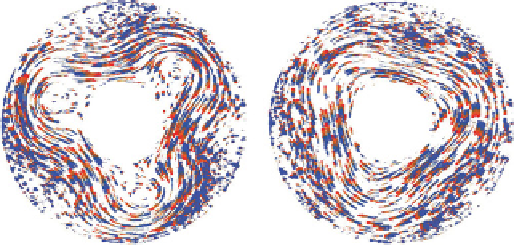Geoscience Reference
In-Depth Information
3
Amplitude Vacillation in Baroclinic Flows
Wolf-Gerrit Früh
3.1. PHENOMENOLOGY OF AMPLITUDE
VACILLATION
The first reference to the term
vacillation
in reference
to baroclinic flows, with a qualitative description, can be
found in a brief note from January 1953 by
Hide
[1953]
on observations in a rotating baroclinic annulus: “One
cycle of this phenomenon, which has been termed 'vac-
illation' begins (say) with a symmetrical wave pattern with
its continuous 'jet'. Some seconds later there is a dis-
tinct leaning backward of the troughs and a decrease of
their width. This is followed by the troughs returning to
N.-S. orientation and then leaning forward in prepara-
tion of the stage when the 'jet' stream is actually inter-
rupted and intense cyclones are formed in the position
of the wave troughs. The cyclones decay and the 'jet' is
re-established; the wave pattern returns to the initial stage
and the cycle starts again. The period corresponds to a
few 'weeks'.” A full description of his observations can
be found in
Hide
[1958], and two typical snapshots of a
vacillating wave number 3 are shown in Figure 3.1. While
it will become apparent in this chapter that this excerpt
describes structural vacillation, rather than amplitude
vacillation, it initiated detailed research into vacillating
flows in many places.
This term vacillation was subsequently taken up as a
technical term and its definition refined, distinguishing
between amplitude vacillation and shape vacillation [
Hide
and Mason
, 1975].
Fowlis and Pfeffer
[1969] characterized
amplitude vacillation based on an array of thermistors
in a large baroclinic annulus. Since then, amplitude vac-
illation has been investigated in laboratory experiments
with a range of thermally driven baroclinic rotating annu-
lus experiments, e.g., by
White and Koschmieder
[1981],
Tamaki and Ukaji
[1985], and
Sitte and Egbers
[2000], in
Figure 3.1.
Two flow stages within an amplitude vacillation
cycle. Courtesy of Peter Read, published in
Lappa
[2012],
Copyright © John Wiley & Sons. Used with permission.
addition to those by Hide and Pfeffer. While these exper-
iments generated the baroclinic flow by thermal forcing
of the sidewalls, it can also be mechanically forced by a
differentially rotating lid in contact with the upper layer
of a two-layer fluid. This system has also been investi-
gatedindetailby
Hart
[1972] and successors. Like the
thermally driven annulus, this two-layer experiment has
also shown amplitude vacillation in experiments with both
two immiscible fluids [
Hart
, 1973, 1976] and salt-stratified
water [
Flór et al.
, 2011].
Another example of flow observations referred to as
amplitude vacillation is from a thermally driven annu-
lus rotated so rapidly that the centrifugal term outweighs
terrestrial gravity [
Azouni et al.
, 1986;
Or and Busse
,
1987;
Schnaubelt and Busse
, 1992]. In that case, the fluid
is no longer stably stratified, and the resulting flow is
closer to rotationally constrained Rayleigh-Bénard con-
vection than to baroclinic instability. The term vacillation
is also used to describe atmospheric phenomena such
as tropospheric wave-zonal flow fluctuations [
Koo et al.
,
2002;
Feliks et al.
, 2011], the stratospheric vacillation
School of Engineering & Physical Sciences, Heriot-Watt Uni-
versity, Edinburgh, United Kingdom.


















